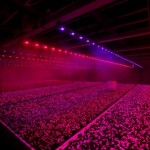As we are moving into the topic of biosphere, we have been discussing factors that influence the growth of trees: temperature, rain, soil, sunlight, etc. We see a clear connection between physical geography and biomes i.e. how one affects the other. In addition, most of our NPS presentations touched on the effects of physical changes – atmosphere, hydrosphere, and lithosphere – on a local species.
It is, however, very interesting to read about the indoor farming. This idea has been created and experimented by a Dutch bioengineer, Gertjan Meeuws, in Den Bosche, the Netherlands. What he is doing does not support what we learn from class, but is very thought-provoking: what kind of conditions can we control to be able to grow plants indoor?
Certainly, this method requires good combinations of light, soil, humidity, and temperature. This is different from the greenhouse conditions because natural sunlight is excluded. However, Meeuws claimed that the growth rate from this method is three times faster than under greenhouse conditions. This method requires LED bulbs which can be expensive, but the cost is getting lower nowadays. Moreover, the indoor farming does not need pesticides, and requires about 90 percent less water than outdoor agriculture.
Other benefits from this way of farming is that it may be one of the answers to the world’s food problems. Food prices are unstable because the climate conditions are uncontrollable i.e. floods, droughts, etc. Not only do we face the price problems, but the limited resources are also challenged by the growth of population. The United Nations predicts that, by mid-century, the world population will increase from 6.8 billion to 9 billion. To feed so many people we expand farmlands at the expense of forests and the wilderness, we also increase crop yields in artificial and radical ways. But, indoor farming is a great alternative to respond to more food demand. It is even possible where farmland is scarce like in a city. Since half the people on Earth lives in cities, it would be a good idea to grow some plants in cities to reduce the transportation cost, especially when the oil price is rising steadily.




I think indoor farming would be a smart idea to solve increasing food prices. As you pointed out, most people live in cities so being able to grow food where the people live will cut back a lot on transportation expenses and drive down the costs. I am not sure if you mentioned this in your blog but how exactly is the growth rate three times faster than the greenhouse method? Also, are the LED bulbs safe to use for growing plants that will be used for food?
This seems like a great idea given the problems the world faces going forward. My only concern would be the effect of LED lights on the food we eat–could it cause the chemical structure of the plant to change? What are the health implications? Generally speaking within science, anything that is not “natural” usually has some sort of health consequence. I would be hesitant about eating the food produced by these farms myself. This is just the type of thing that we spend 50 years eating, then find out from future generations that it causes cancer or some other XYZ disease we don’t know about yet. However, from the start, it seems like a great way to tackle our future food shortages. I can just picture an enormous skyscraper in downtown New York that essentially feeds the entire city with plants from all over the world.
Interesting article! I love reading about new farming technology. The ideas proposed here raise many questions for me. For one, if indoor farming were to move into the cities, where would it go? Isn’t the reason we don’t have crops growing in the cities because we don’t have the surface area to grow plants? And if we decided to use rooftops, for instance, wouldn’t it make more sense to have crops grow outdoors rather than invest in the infrastructure and the energy/electricity required to grow indoor crops?
I could see indoor farming being useful on a very small, individual scale. Families want to have fresh, local vegetables year-round but live in Montana? Create a small, indoor garden patch in a closet or boarded up porch!
Because these indoor farms wouldn’t receive natural sunlight, I could see their energy demand being very high. However, the lowered water consumption might become increasingly relevant as our water supply disappears. Still – how does the total cost/benefit weigh out? Indoor farming still requires a lot of infrastructure development. Farmers would have to construct tents/buildings and invest in maintenance.
Growing food indoors sounds like a nice option in dire circumstances, but it doesn’t seem like a default farming method to me. While current farming practices consume a lot of water and pesticides, it is possible to farm outdoors curbing use in both these areas. Organic and local food help do this, as well as applying natural soil additives such as biochar, which increases soil retention. Artificial and radical changes may seem necessary given such a huge jump in population, but it is important we consider sustainability first and foremost in making agricultural adjustments. It doesn’t do much good to feed 9 million people for 5 years and then suddenly only be able to feed 7 million.